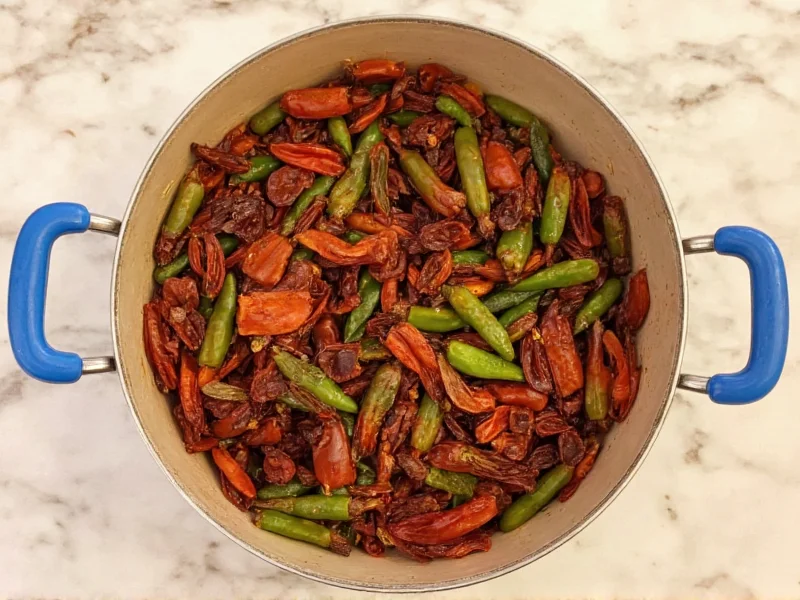Rehydrating dried chiles transforms these shelf-stable ingredients into vibrant flavor powerhouses essential for authentic Mexican moles, adobos, and salsas. This fundamental technique bridges the gap between pantry staples and restaurant-quality results, making it indispensable for home cooks seeking depth in their dishes.
Why Proper Rehydration Matters
Dried chiles contain concentrated capsaicinoids and aromatic compounds that only fully activate when properly reconstituted. The rehydration process:
- Restores moisture content for optimal blending
- Activates flavor compounds dormant in dried state
- Softens tough skins for easier processing
- Prevents bitter notes from under-hydrated chiles
Skipping proper rehydration yields thin sauces with uneven texture and muted flavor profiles. Understanding how to rehydrate dried chiles for sauce making separates authentic preparations from disappointing imitations.
Step-by-Step Rehydration Methods
Three reliable techniques exist for rehydrating dried ancho chiles and other varieties, each suited to specific applications:
| Method | Best For | Time Required | Water Temperature |
|---|---|---|---|
| Hot Water Soak | Most applications (moles, adobos) | 15-30 minutes | 175°-190°F |
| Cold Water Soak | Delicate chiles (guajillo, pasilla) | 30-60 minutes | Room temperature |
| Steam Rehydration | Chiles for stuffing or presentation | 10-15 minutes | N/A |
Hot Water Method (Most Common)
- Remove stems and shake out loose seeds (keep some seeds for extra heat)
- Lightly toast chiles in dry skillet 15-30 seconds per side until fragrant (optional but recommended)
- Place in heatproof bowl and cover with hot water (just off boil)
- Weight down with small plate to ensure full submersion
- Soak 15-30 minutes until pliable but not mushy
- Drain thoroughly, reserving 1 cup soaking liquid for sauces
This best way to rehydrate dried chiles works for anchos, mulatos, chipotles, and most common varieties. The hot water technique rapidly reconstitutes while preserving complex flavor compounds.
Cold Water Method (For Delicate Varieties)
Use for thin-skinned chiles like guajillo or pasilla that can become waterlogged:
- Follow steps 1-2 above for preparation
- Soak in room temperature water 30-60 minutes
- Check frequently to prevent over-soaking
This gentler approach maintains structural integrity for chiles destined for whole use in stews.
Troubleshooting Common Issues
Even experienced cooks encounter challenges with rehydrating dried chiles for mole. Here's how to solve frequent problems:
Chiles Remain Tough After Soaking
If chiles stay leathery after 30 minutes:
- Water temperature was too low – use near-boiling water
- Chiles weren't fully submerged – weight them down
- Older chiles require longer soaking – extend time up to 45 minutes
Mushy or Disintegrating Chiles
Over-soaked chiles lose flavor and texture:
- Reduce soaking time for subsequent batches
- Use cooler water for delicate varieties
- Check chiles every 5 minutes during final soaking phase
Using Rehydrated Chiles Effectively
Properly rehydrated chiles should feel supple but retain structure. For how long to soak dried chiles before blending, follow these guidelines:
- Sauces and purees: Soak until completely flexible (20-30 minutes)
- Stews and braises: Soak just until pliable (15-20 minutes)
- Stuffing whole: Steam rehydrate to maintain shape
Always drain thoroughly before processing – excess water dilutes flavor. Reserve soaking liquid to adjust sauce consistency while maintaining chile essence.
Storage Guidelines for Rehydrated Chiles
Rehydrated chiles keep refrigerated for 3-4 days or frozen for 6 months:
- Pat dry with paper towels before storing
- Place in airtight container with minimal soaking liquid
- Freeze flat in zip-top bags for easy portioning
- Label with variety and date for recipe accuracy
Never store rehydrated chiles in plain water – this leaches flavor and promotes spoilage.
Advanced Tips for Flavor Optimization
Professional chefs enhance rehydrated chiles through these techniques:
- Add 1 tsp vinegar to soaking water to brighten flavors
- Toast chiles before rehydration for deeper complexity
- Combine soaking liquid with roasted garlic for sauce base
- Strain blended sauces through fine mesh for silky texture
Understanding proper technique for rehydrating dried chiles transforms good dishes into exceptional ones by maximizing the nuanced flavors these ingredients offer.











 浙公网安备
33010002000092号
浙公网安备
33010002000092号 浙B2-20120091-4
浙B2-20120091-4